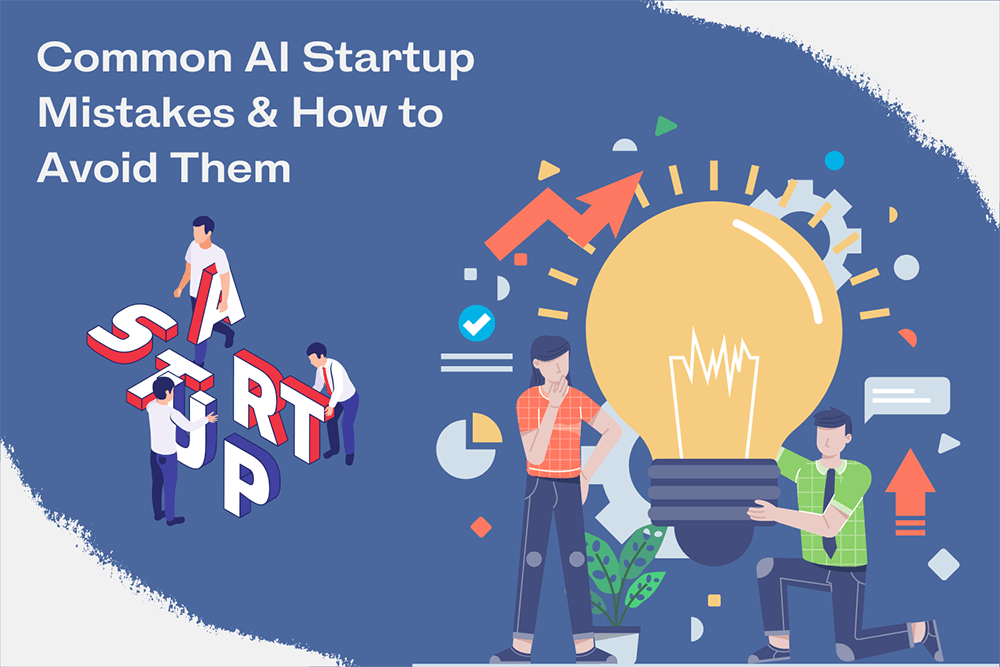Indeed, artificial intelligence has been able to innovate and transform the way many modern companies and sectors operate. Companies in the AI market are expected to generate more than $100 billion by 2025. The potential future of AI is enough of an incentive for new firms to enter the fray and compete in the hypercompetitive AI market.
This post will provide a thorough overview of the most common AI startup mistakes and how to avoid them.
Following are the most common AI startup mistakes and how to avoid them :
Mistake 1 : Choosing the Wrong Structure
One of the most typical mistakes made by AI startups is concentrating too much on the breakthroughs and not enough on the business. This is an important factor to consider while developing your company. How you organize your company might have long-term consequences for the survival of your firm, especially if you experience losses or have liability difficulties.
When you first start out, it may be tempting to operate as a sole proprietorship to save money. However, digital firms tend to expand quickly, and sole proprietorships are risky for larger enterprises. Instead of forming a sole proprietorship, you can consider forming a limited liability corporation (LLC).
Mistake 2 : Ignoring Technical Debt
Technical debt is described as the effects of badly written code or poor development practises. While this can have monetary consequences, it is primarily about features that are either not performing efficiently or will become obsolete as your AI improves. And, given how quickly AI technology may evolve, this is something to be extremely cautious of.
According to Towards Date Science, one prevalent type of technical debt is trash features. Garbage features, as the term indicates, are characteristics that aren’t really valuable. Another feature they have is that you can’t get rid of them. The legacy feature is a typical form of trash feature. These are elements available in earlier editions of the AI that become obsolete as it evolves.
One excellent technique to avoid this is to rigorously condense your AI’s features and ensure that each one works successfully at each level of its development. You’ll want to do this from the start if you want to avoid unforeseen consequences when a long-standing feature is abruptly withdrawn.
Mistake 3 : Generating Loyalty
It has been shown that there is a direct relationship between a pleasant user experience and loyalty. Customers that are satisfied likely to spend more, return more frequently, and tell their friends. We view design as a direct path to free marketing via the positive word of mouth it fosters.
People are more sophisticated than even five years ago, and they will not tolerate a badly designed product or service if there is a better option. Your consumers’ experience is the primary point of contact with your brand; thus, it is critical that you work hard on this. If it evokes unpleasant emotions, they will almost certainly never return (or even worse use their network to harm your brand through a bad review).
Mistake 4 : Chasing investors, not customers
Just because you have a brilliant concept does not guarantee that you will receive funding. One of the most secure methods to assure your startup’s sustainability is to create a business plan that allows the product to pay for itself. So many entrepreneurs are far too focused on developing a pitch rather than developing a company. Forget about money and focus on finding a consumer who will pay for your goods. Then look for another, and another. Get some clients, and investing will be much simpler.
Also, if you’re seeking for funding, concentrate on establishing your product vision and story rather than the (fabricated) stats. If you’re a genuine entrepreneur, you should be more concerned with the things you can control (creating a great product and keeping consumers satisfied) than the ones you can’t (chasing VCs, angel investors, etc.).
Mistake 5 : Failing to ask for help
Entrepreneurs may be a difficult bunch. There is no danger in seeking assistance early on, but far too few people do. There are experts out there that want to help you rather than just line their own wallets. Why make your own errors when people who have gone before you can point you in the right direction?
Accept that you do not know everything and, when required, seek assistance (or even before). As an entrepreneur, it may be a lonely place, but the more you can talk about your business’s issues, the stronger your position will be when chances emerge.
Spend time looking for a solid mentor you can trust and who is really interested in the success of your business.
Mistake 6 : Hyper-Focusing on one opportunity
As a business, the last thing you want to be is inflexible. While you may have a vision for your firm, there is no value to focusing just on one objective or opportunity. Because the AI sector is fast-paced and ever-changing, you must be prepared to adapt.
One way to accomplish this is to keep your eyes open for opportunities to pivot. While your technology, or even your business strategy, may appear to limit your options, this may not be the case.
Five, a self-driving firm, is an example of this. Five’s original idea was to run fleets of self-driving cars as a transportation service. As competition grew, they shifted their focus to licensing their technology to assist other firms in developing self-driving car systems. This decision resulted in $41 million in funding for Five, allowing them to push their technology even further than if they had stayed with their original vision.


